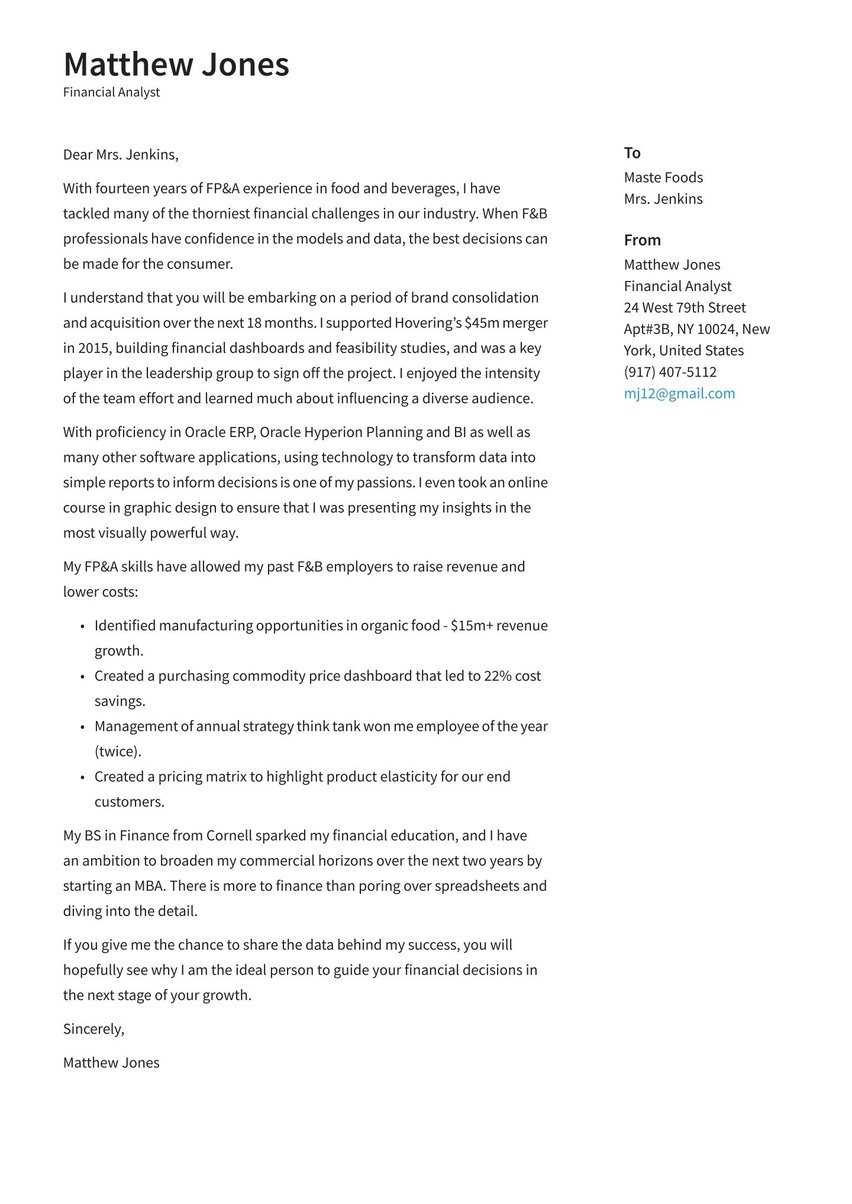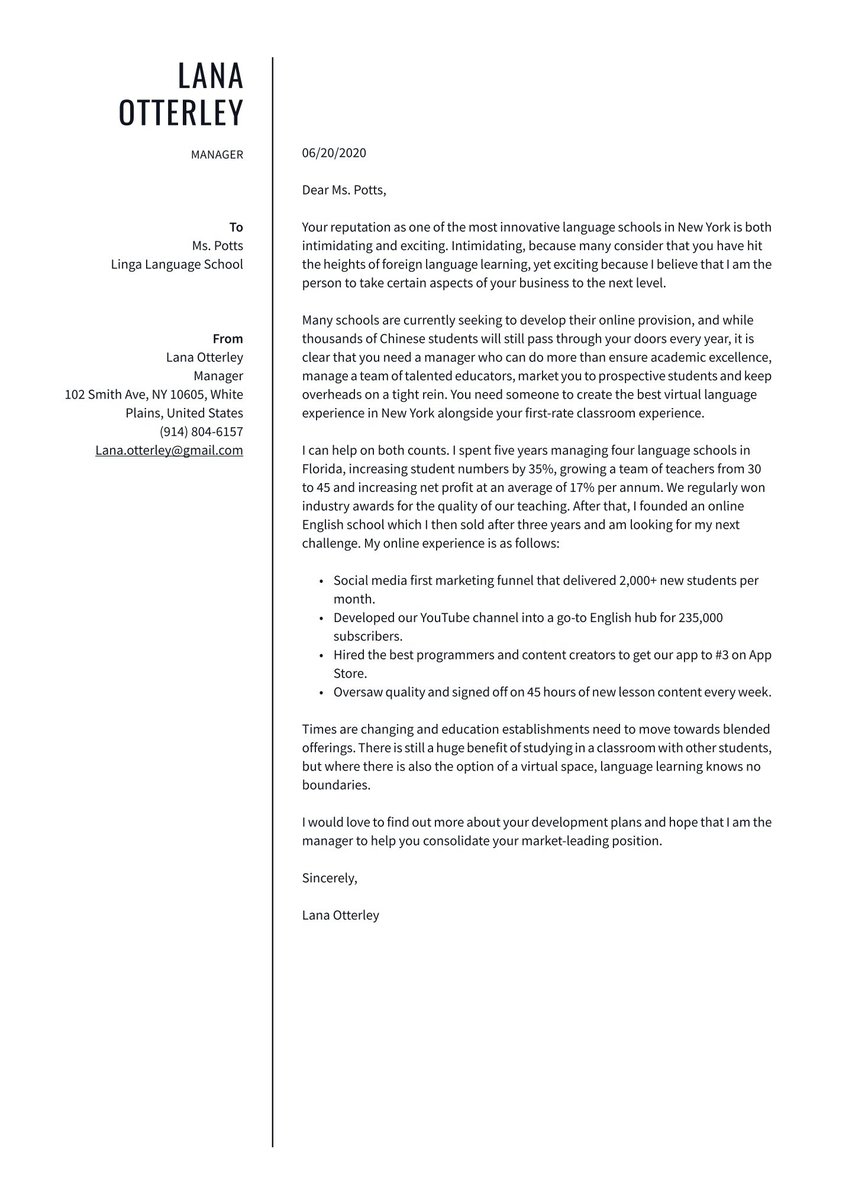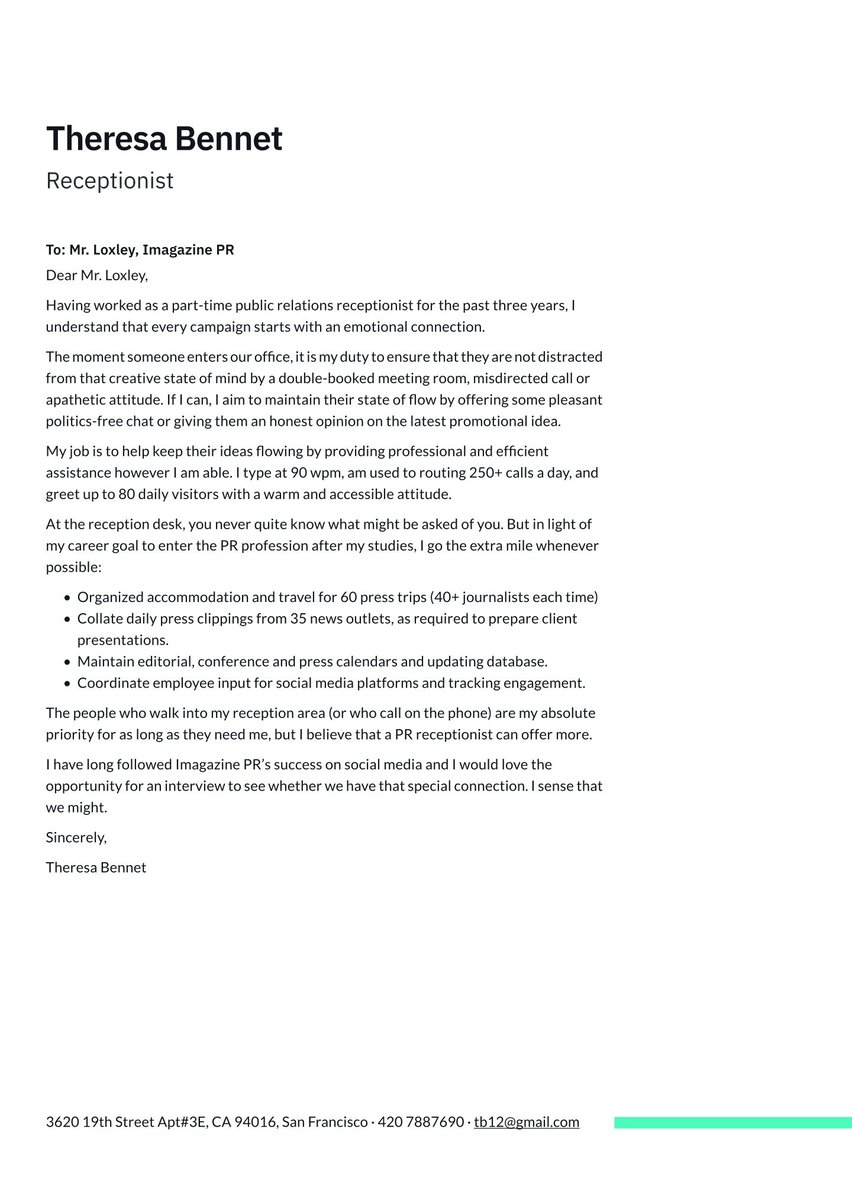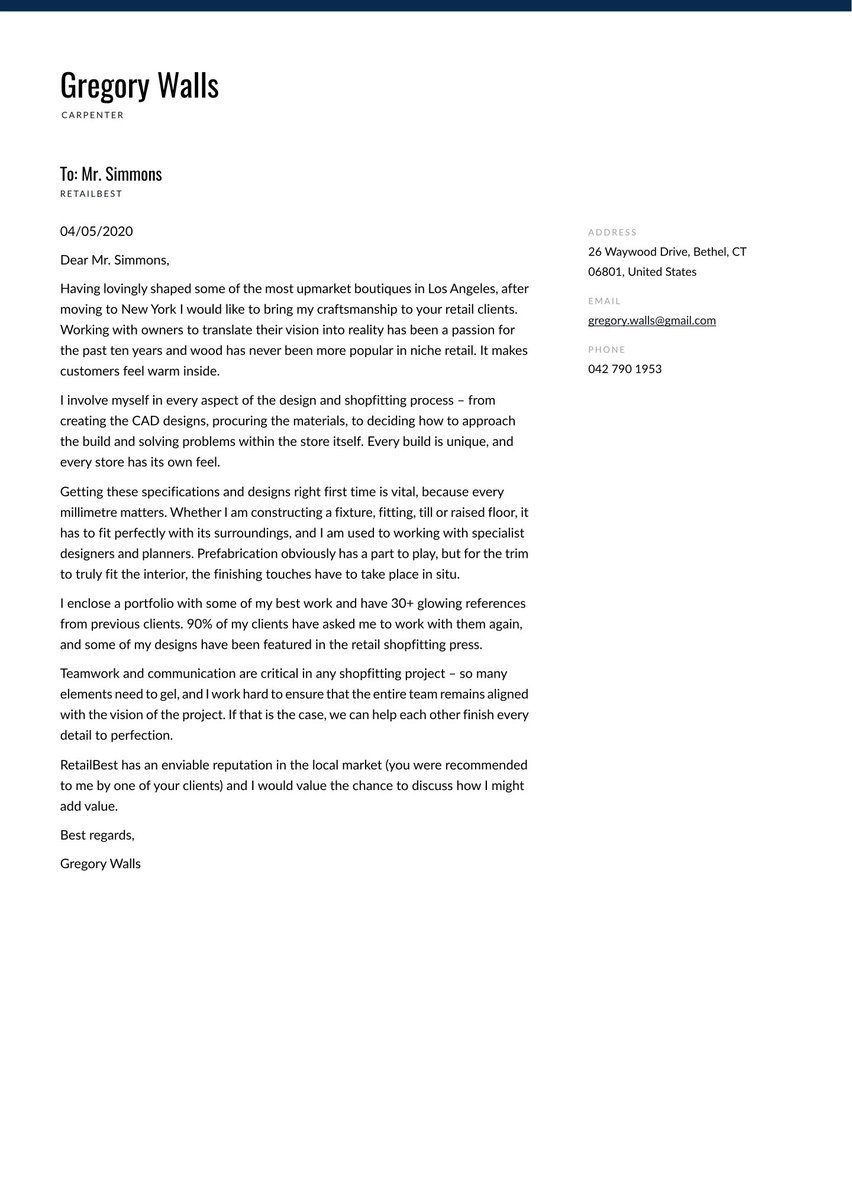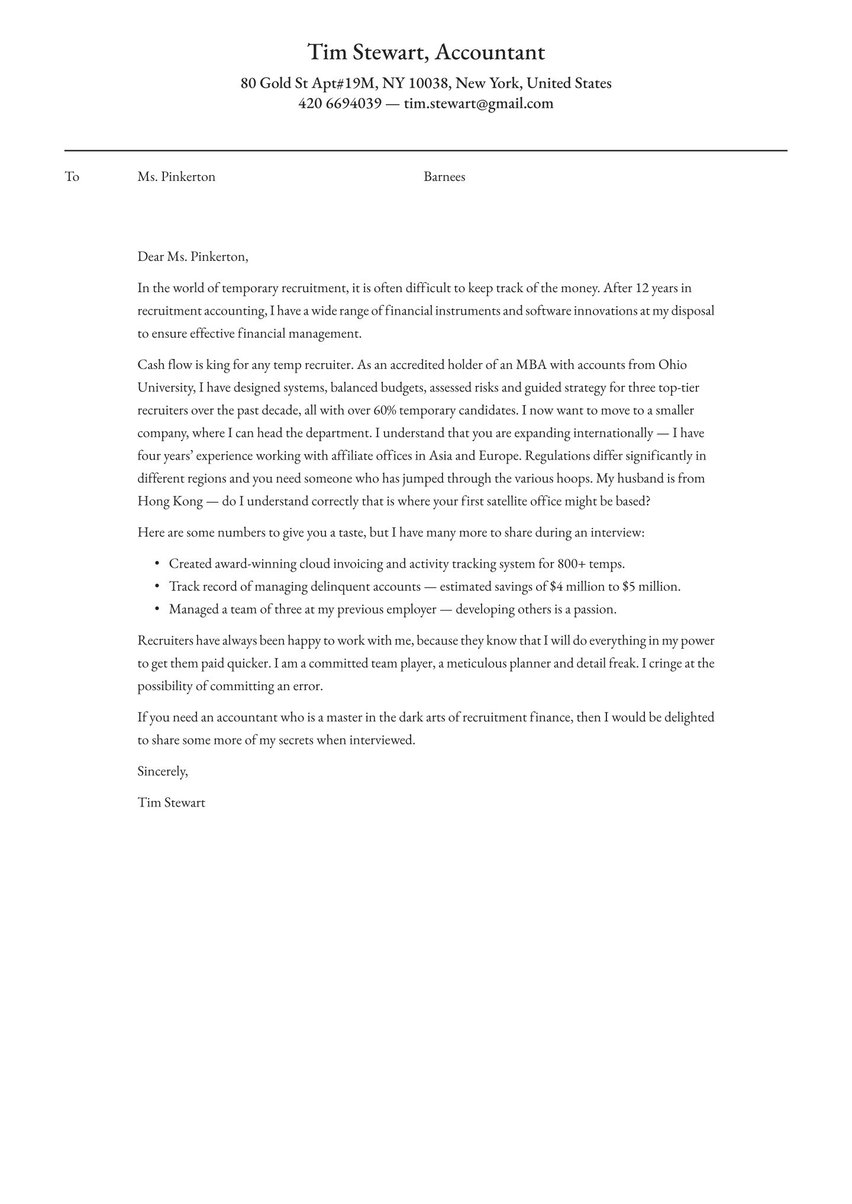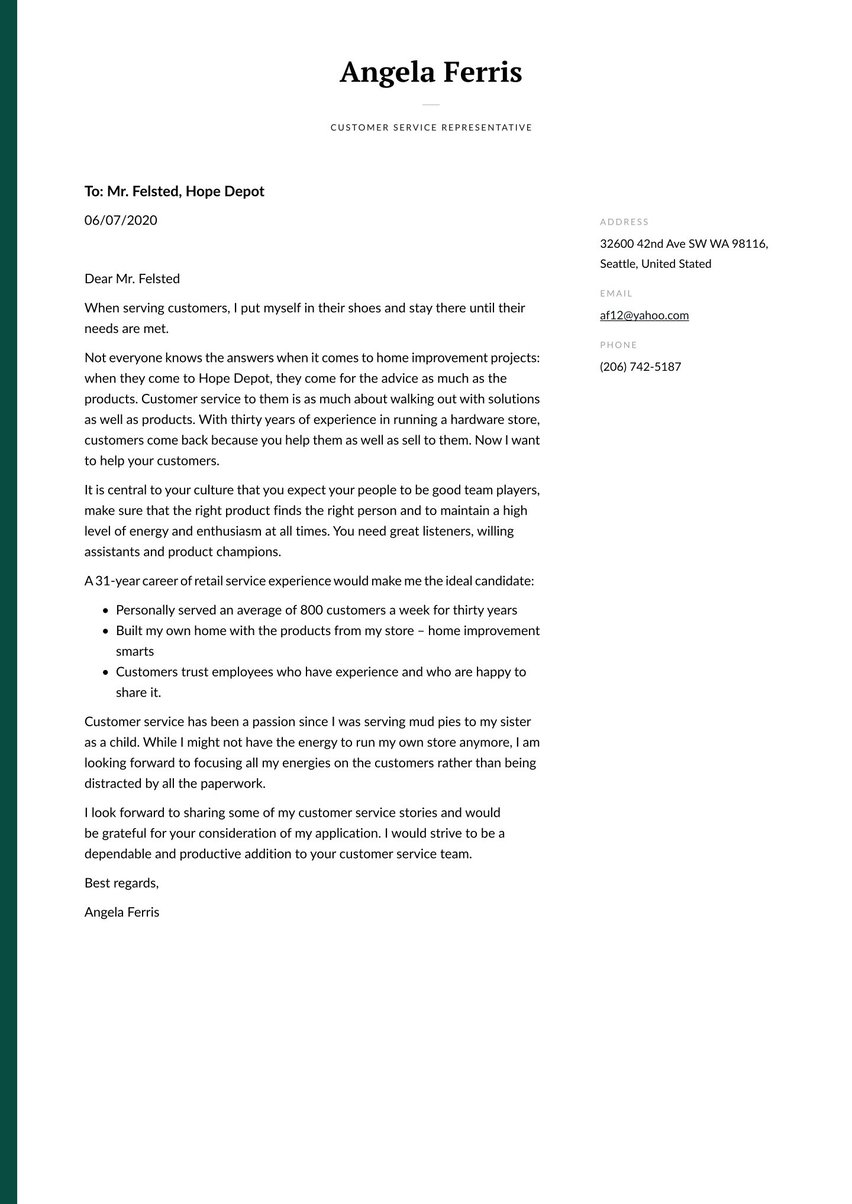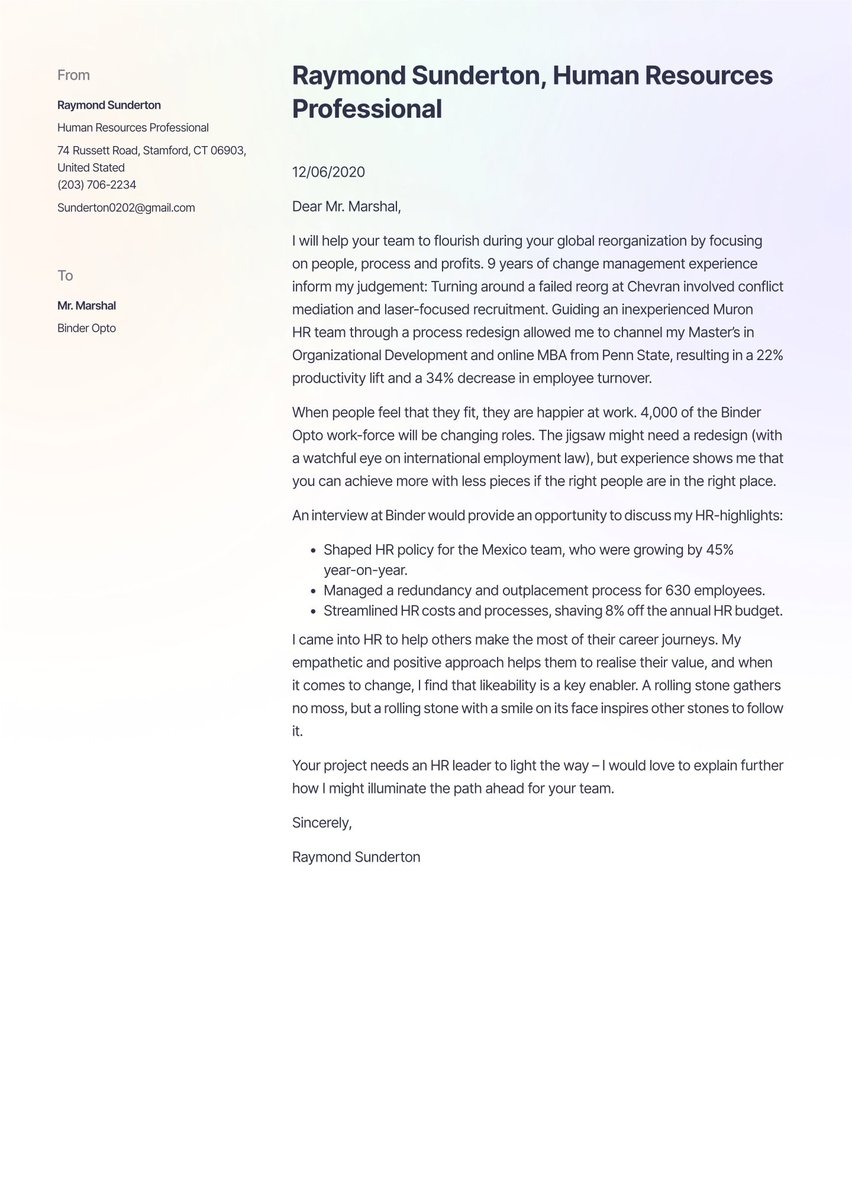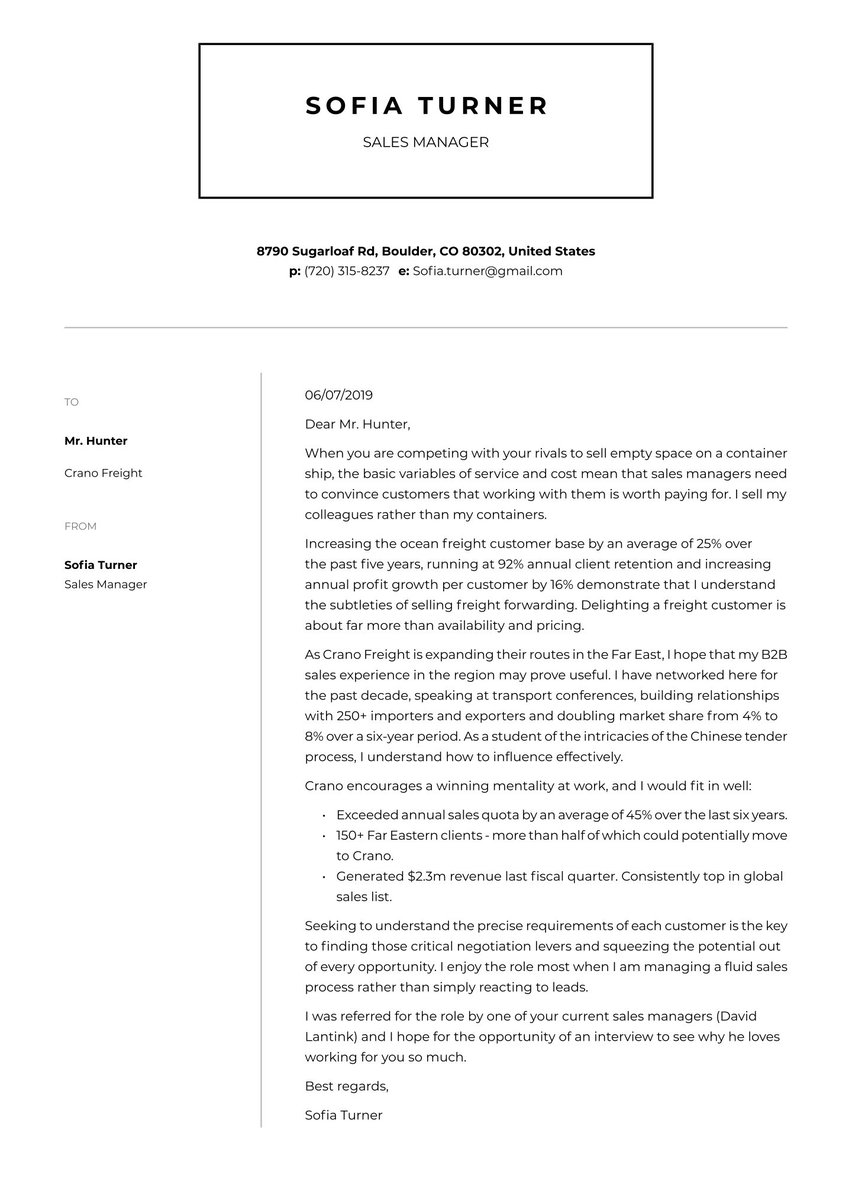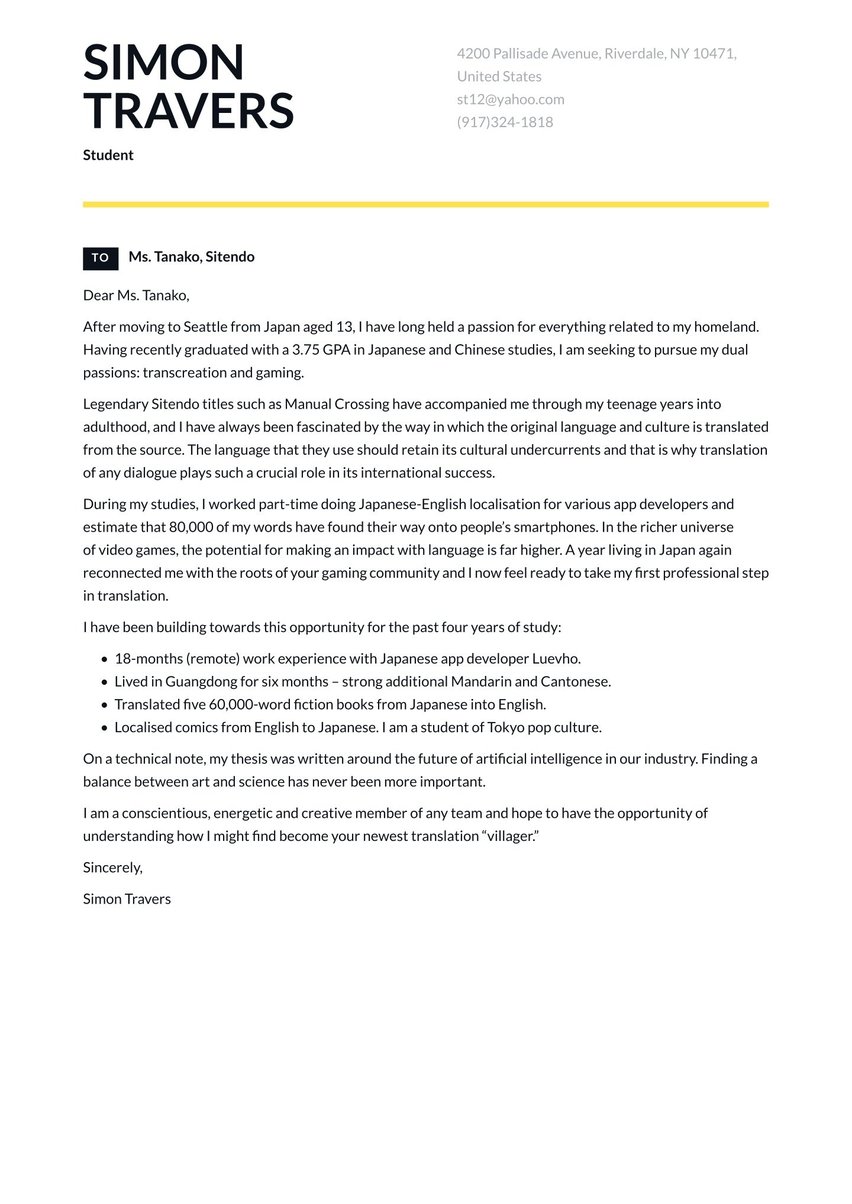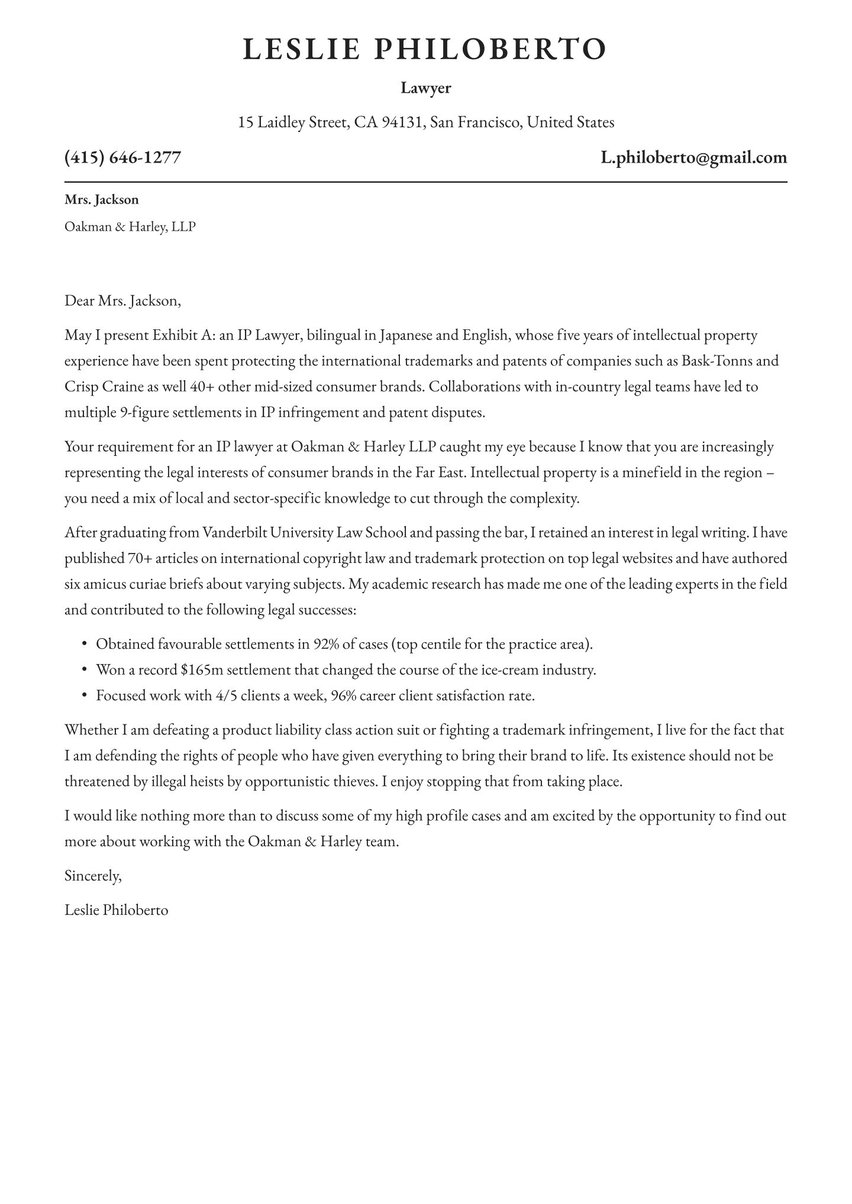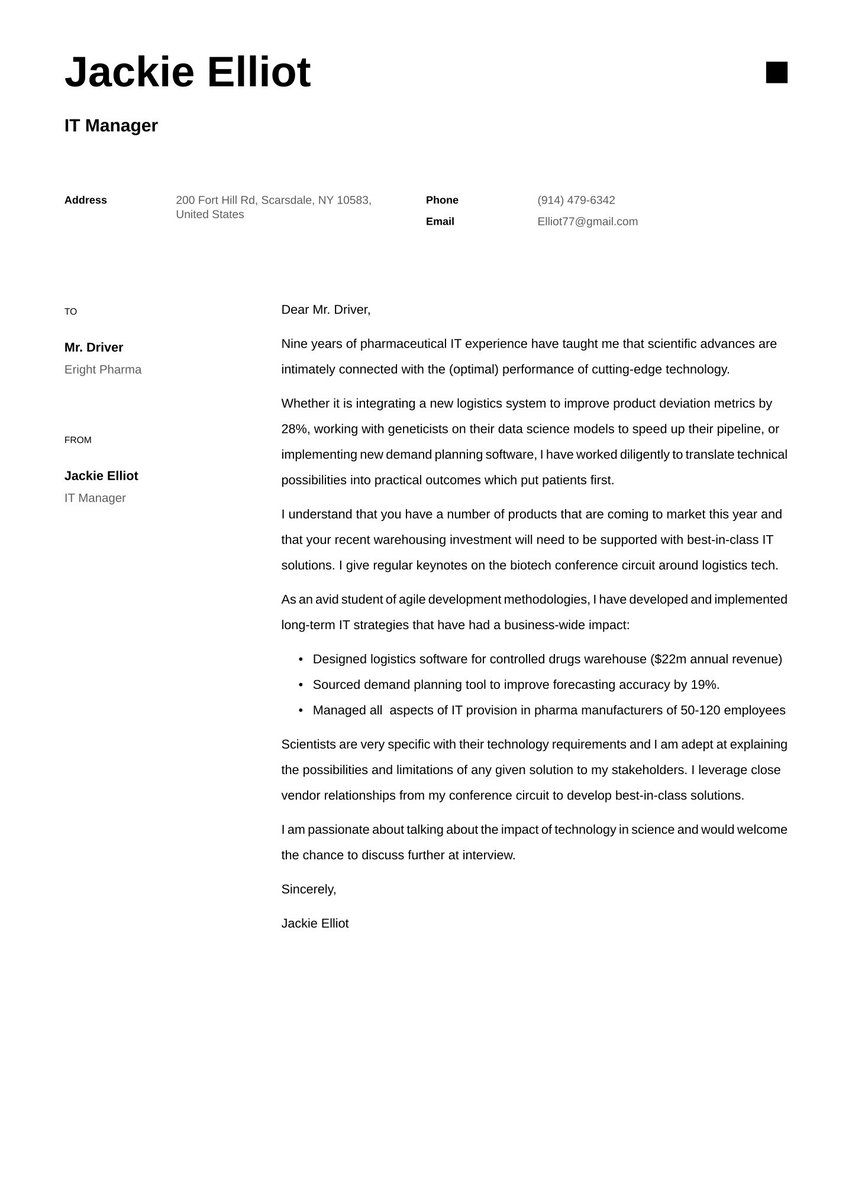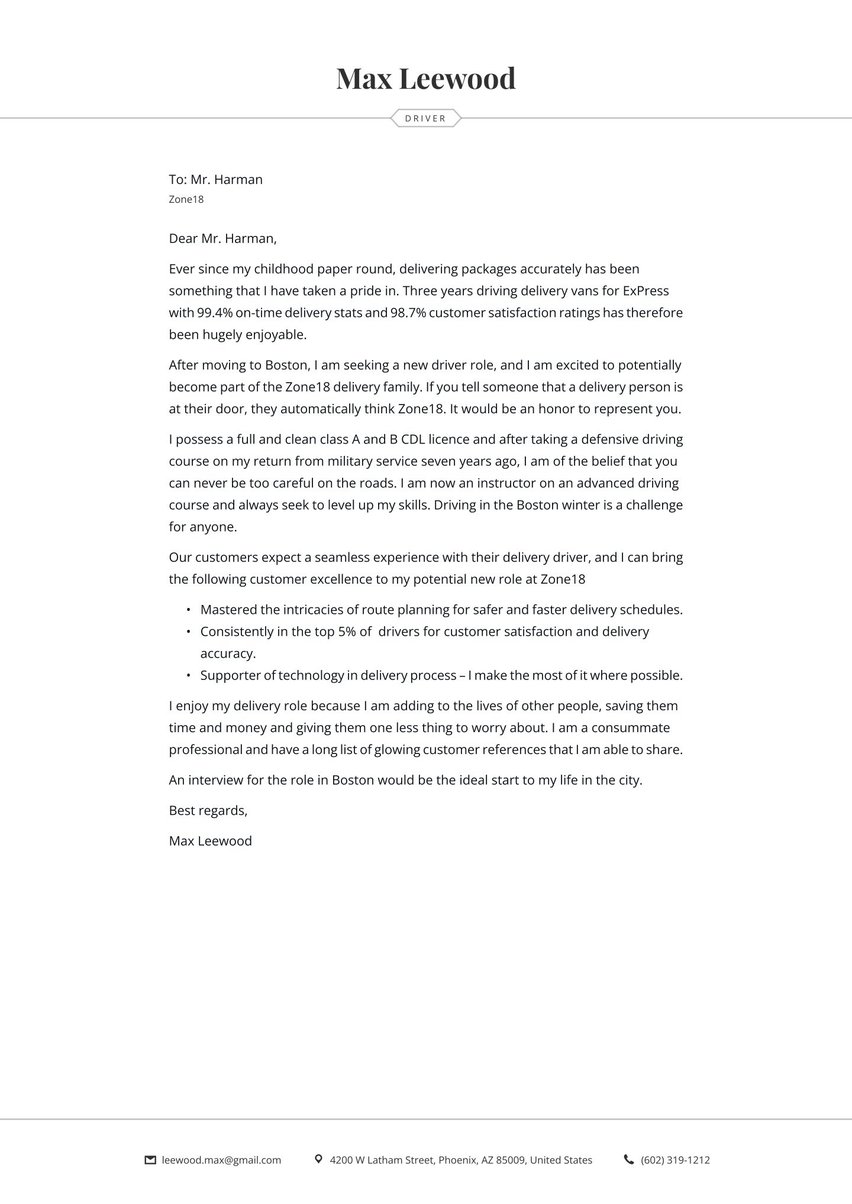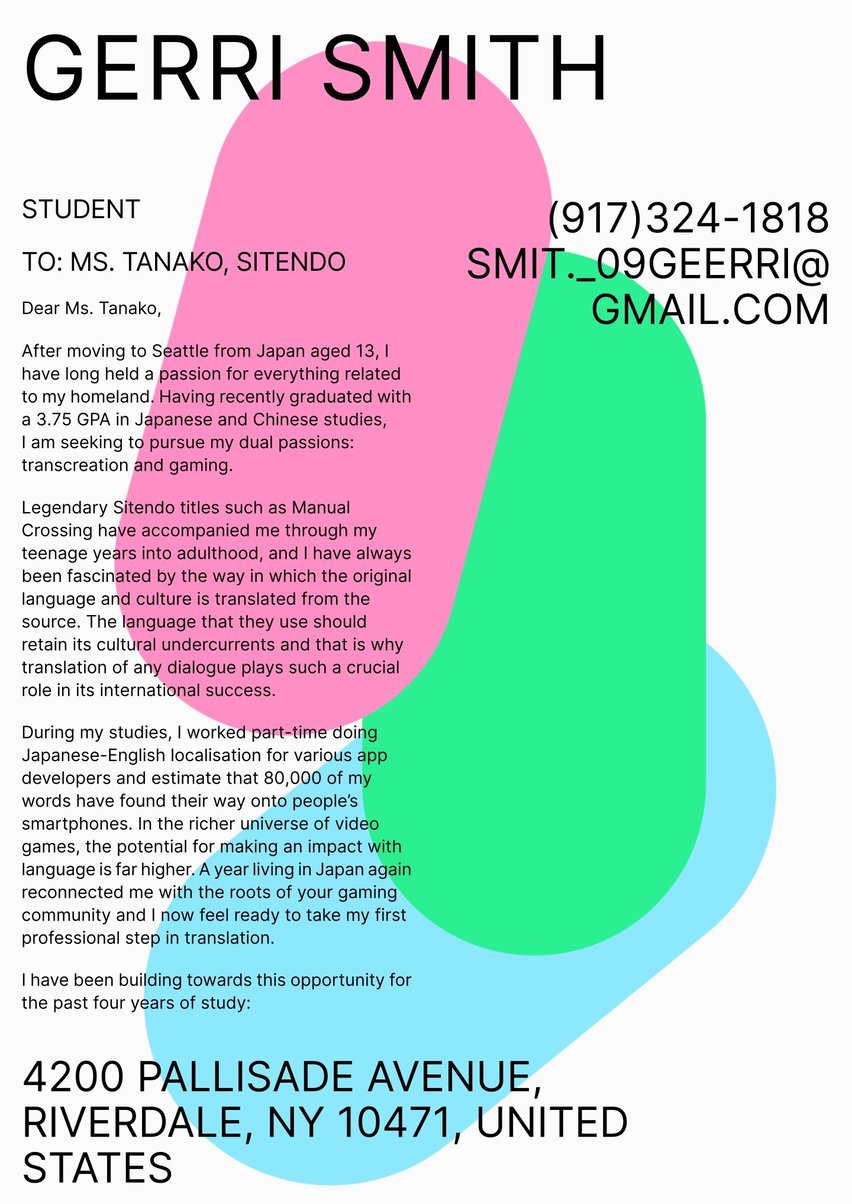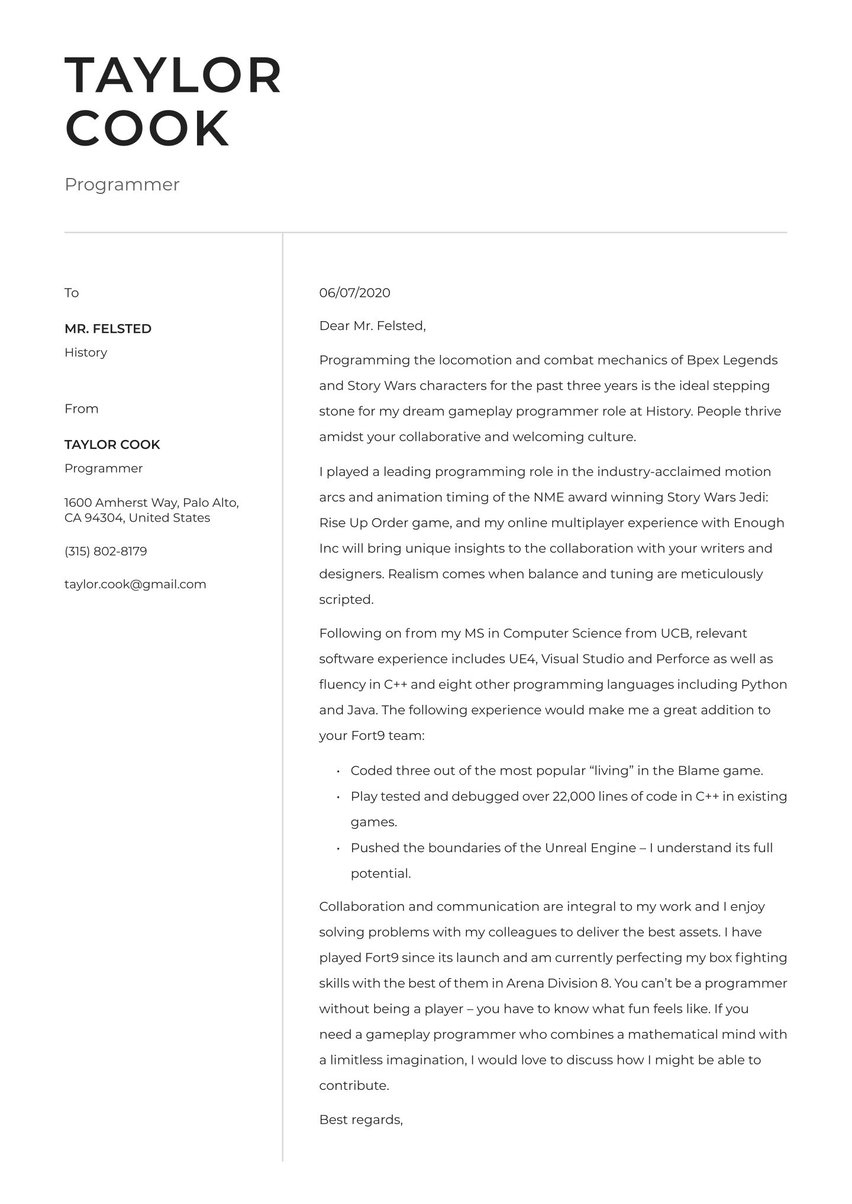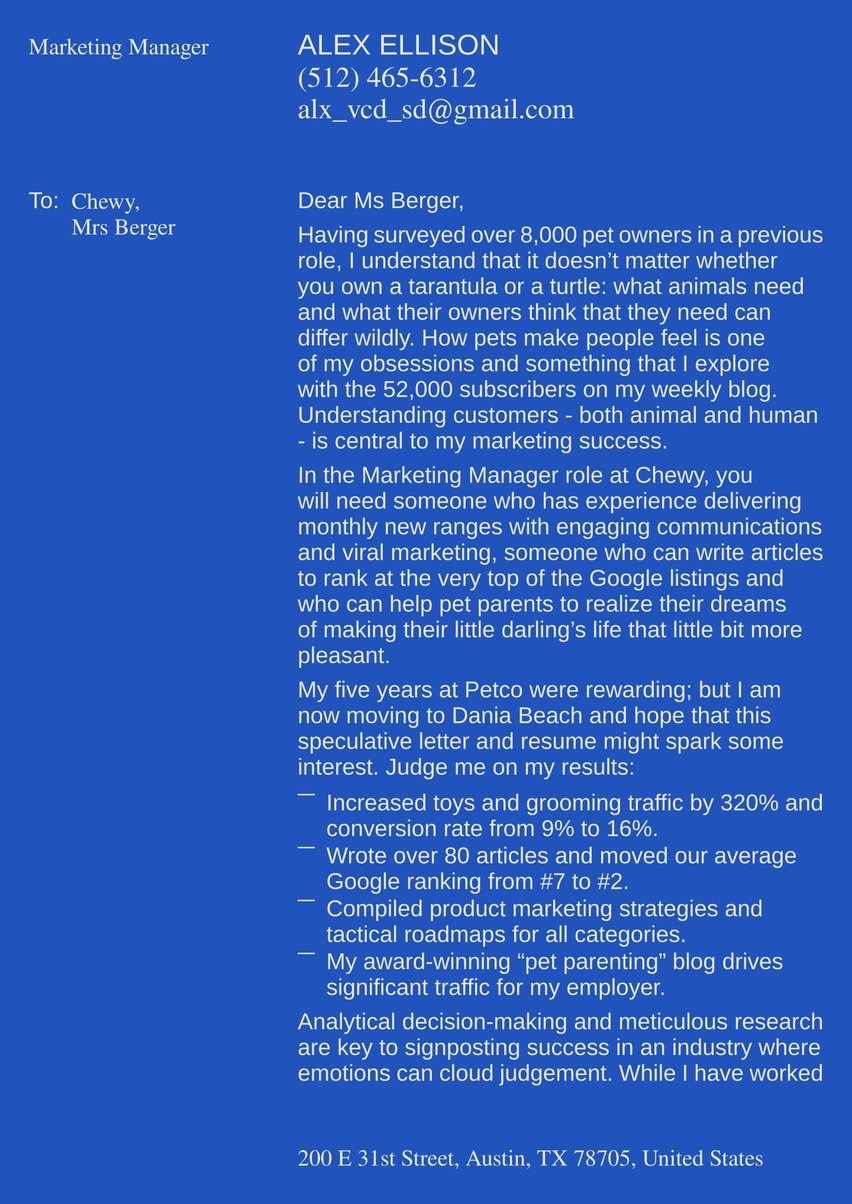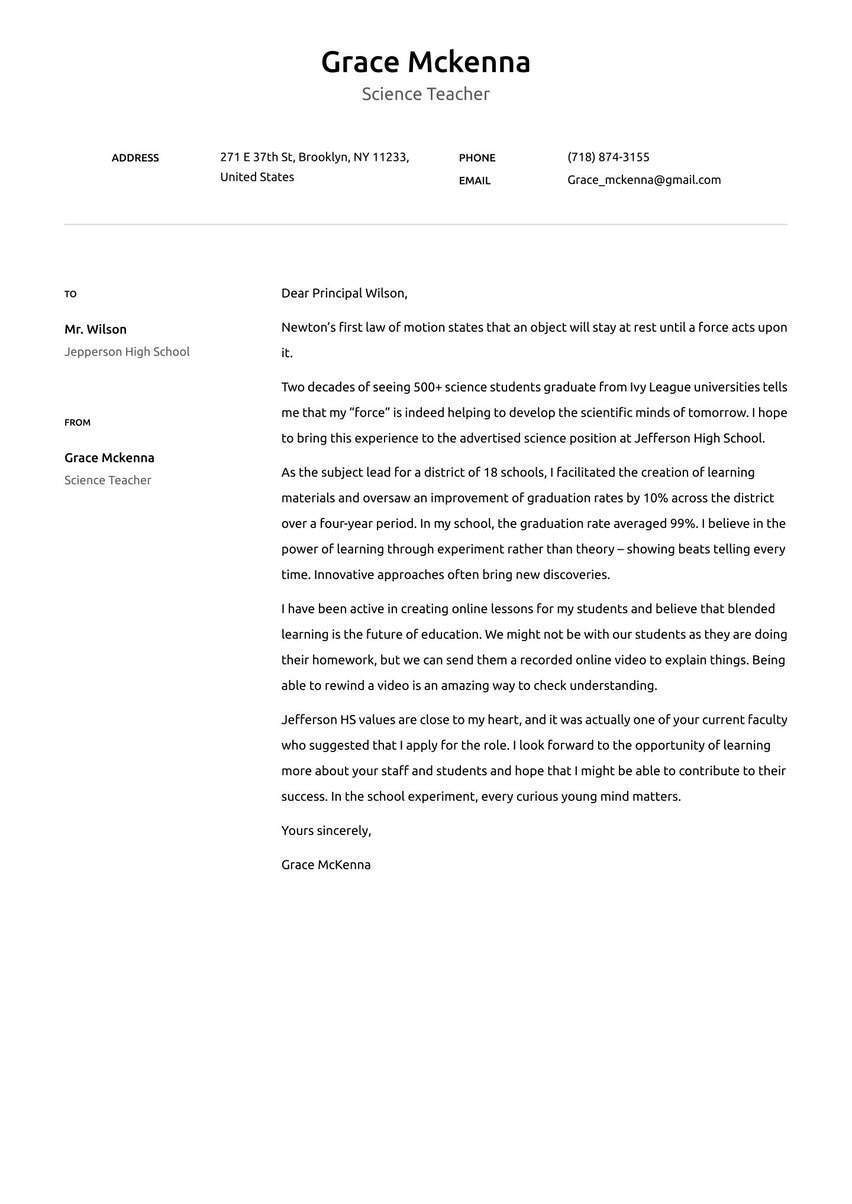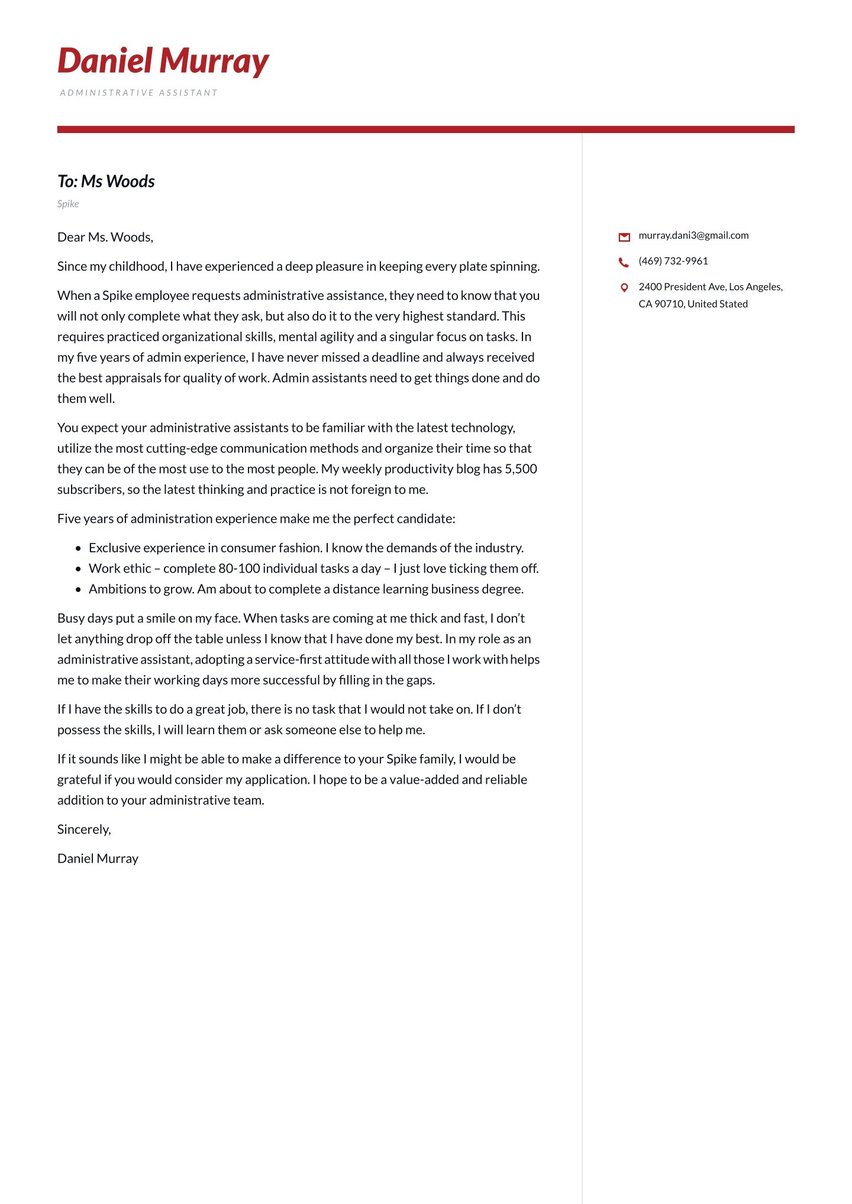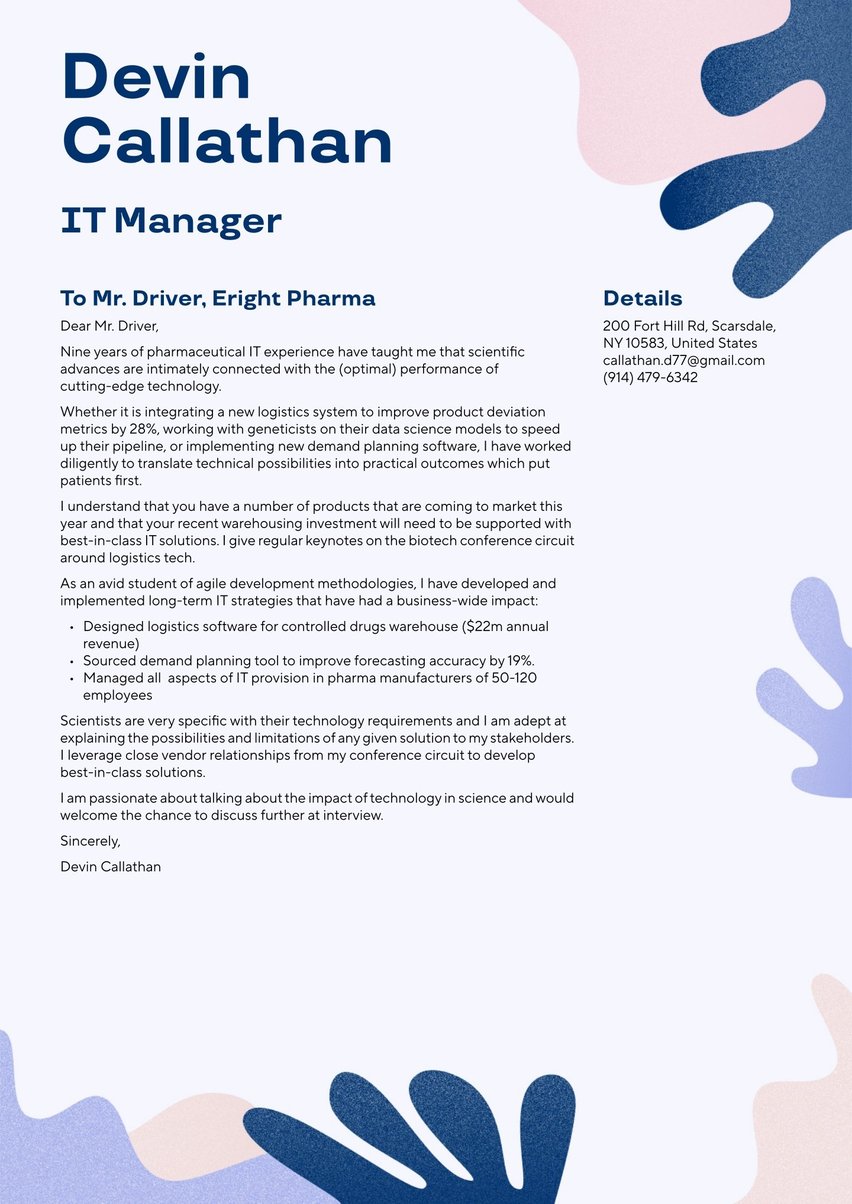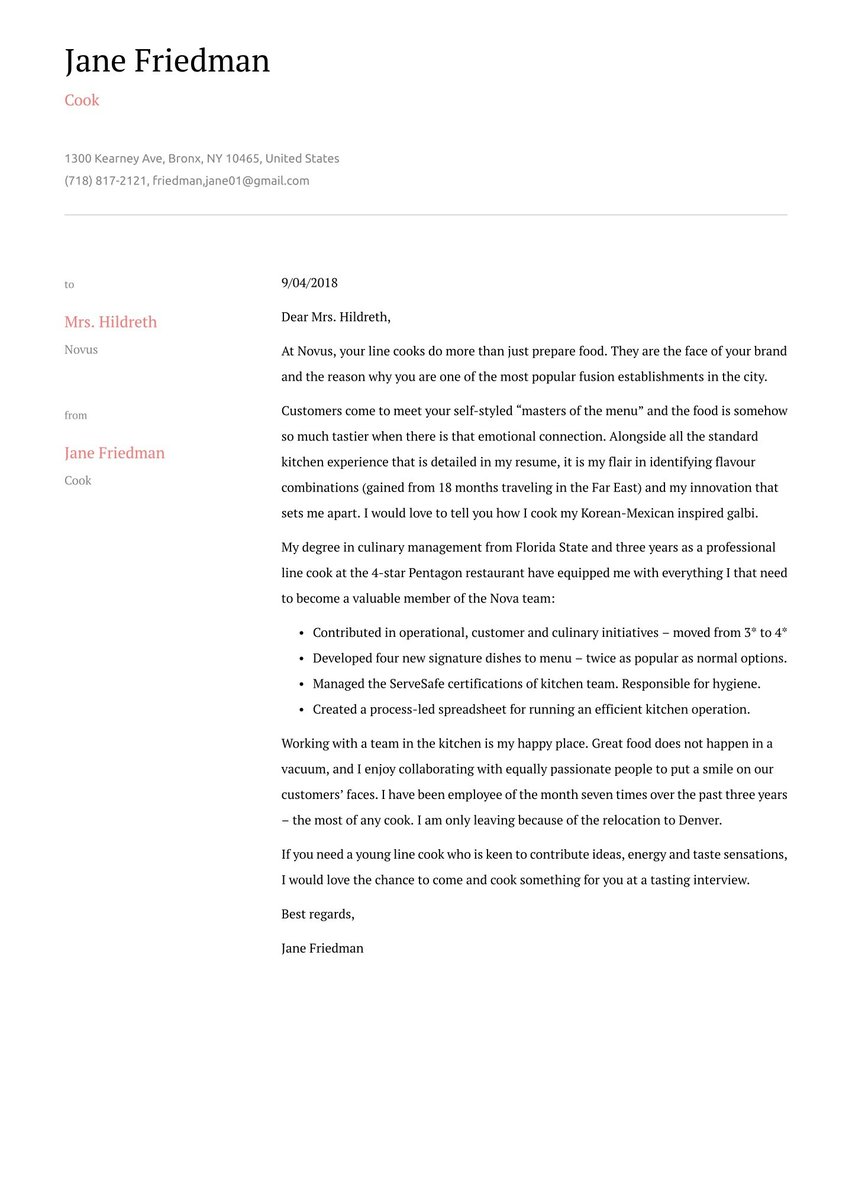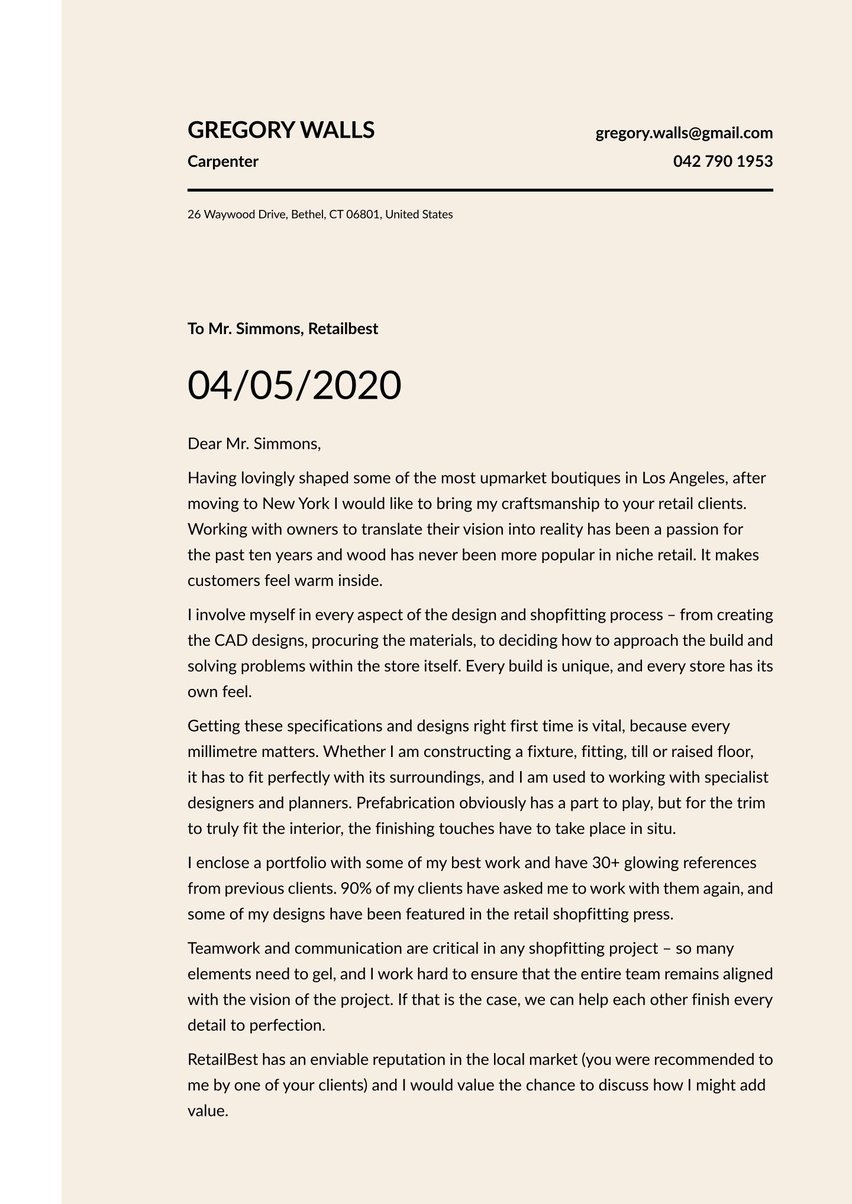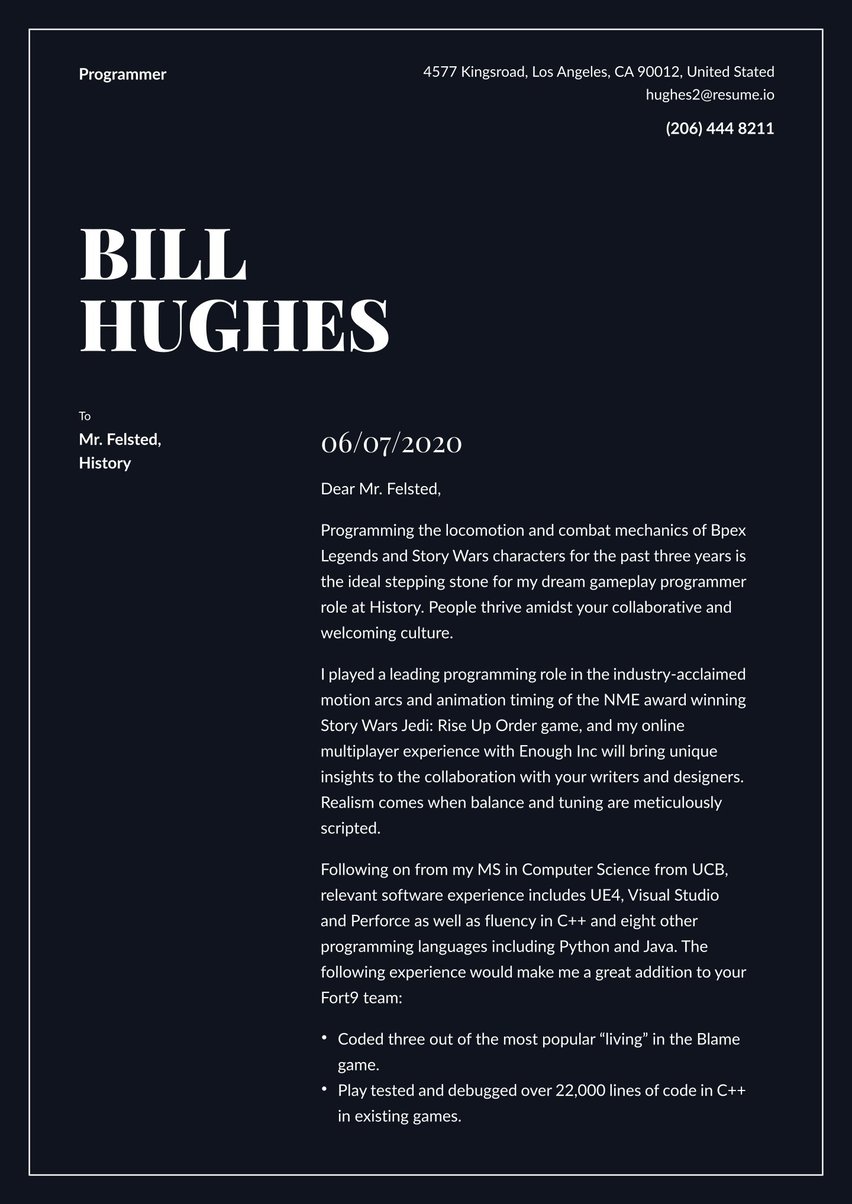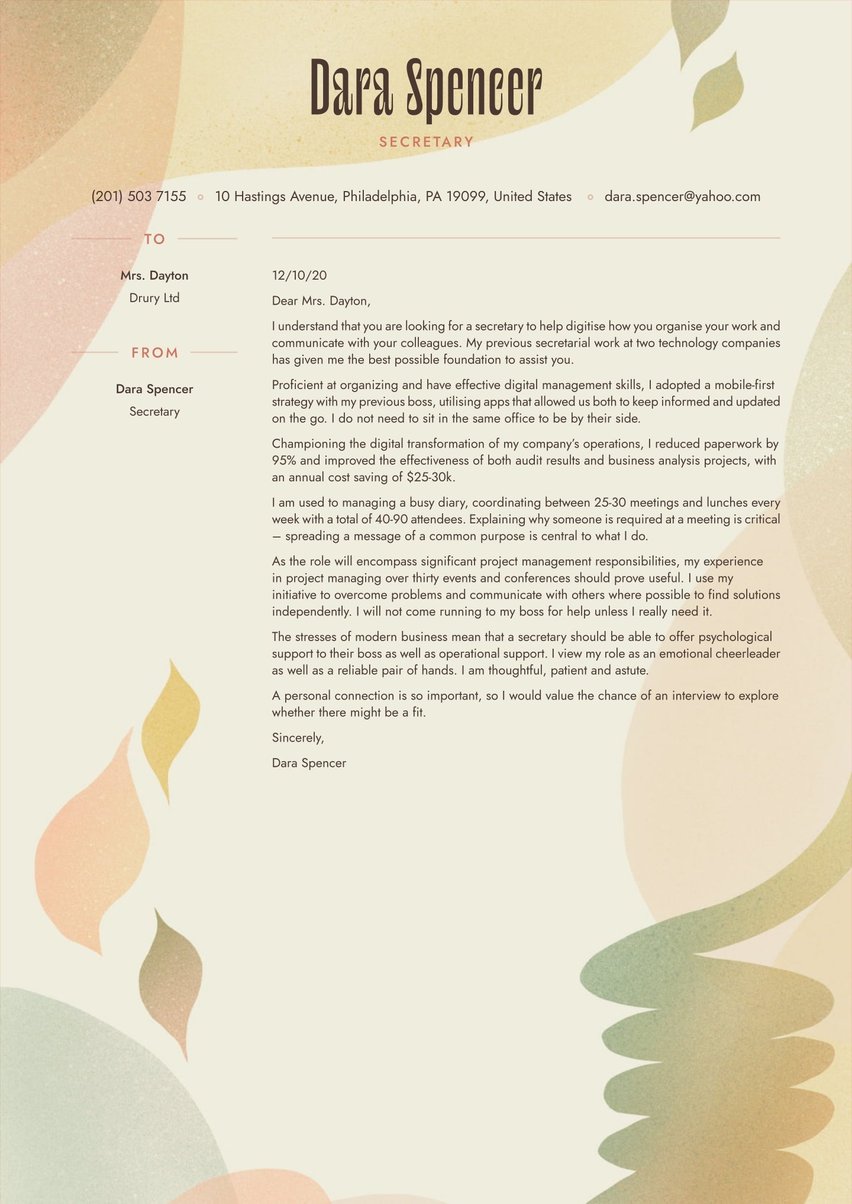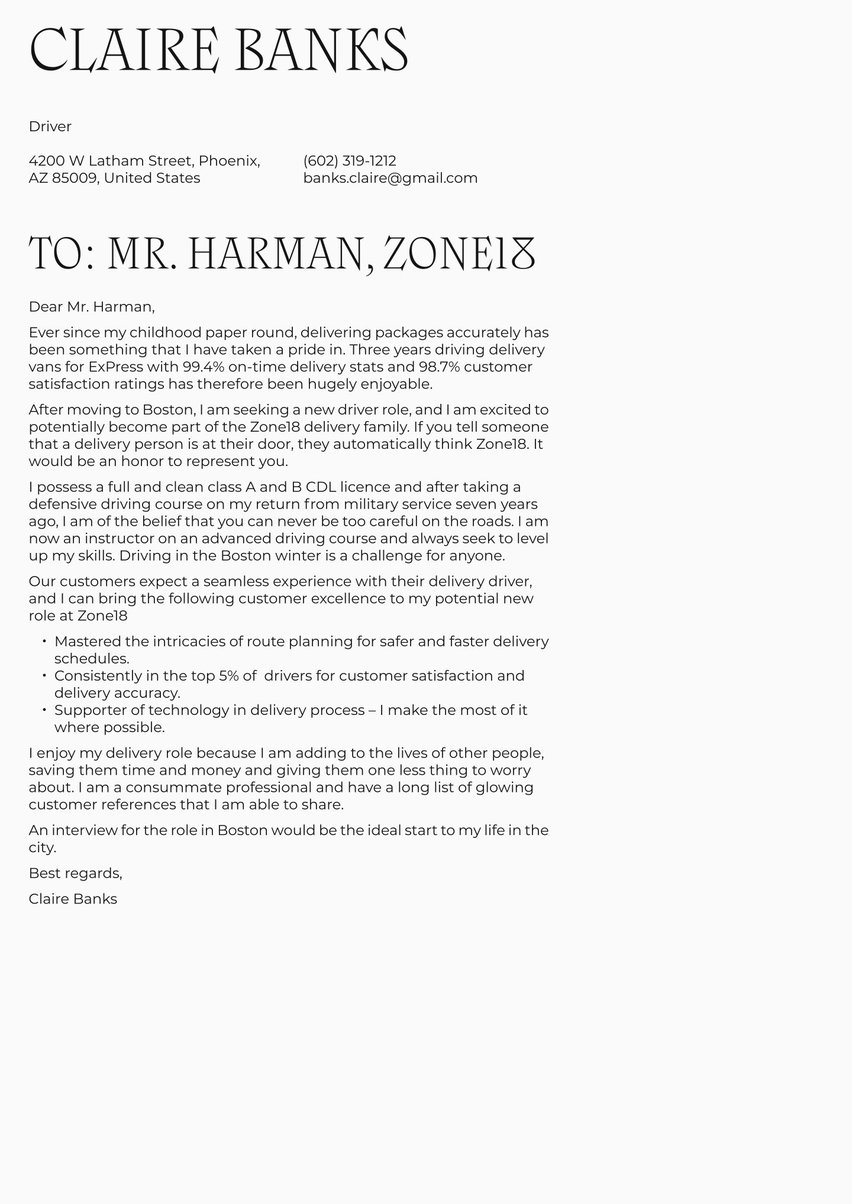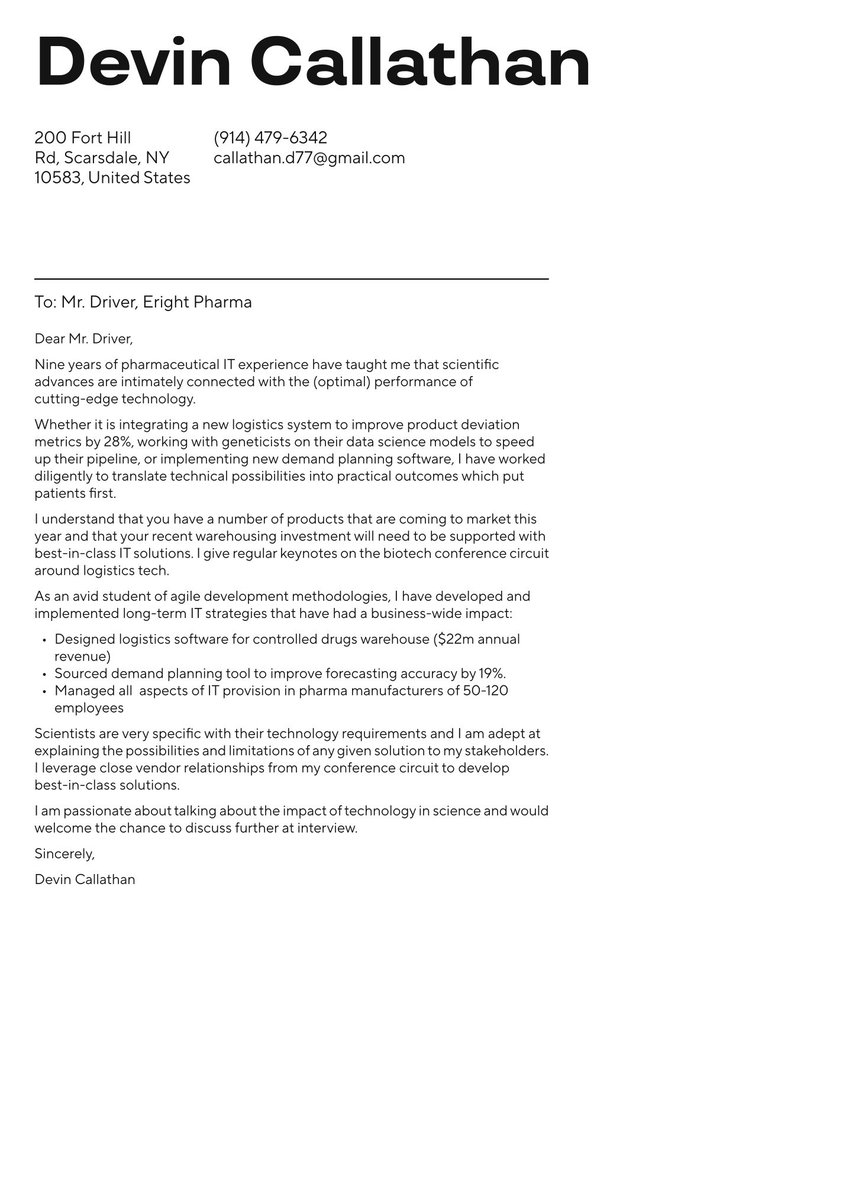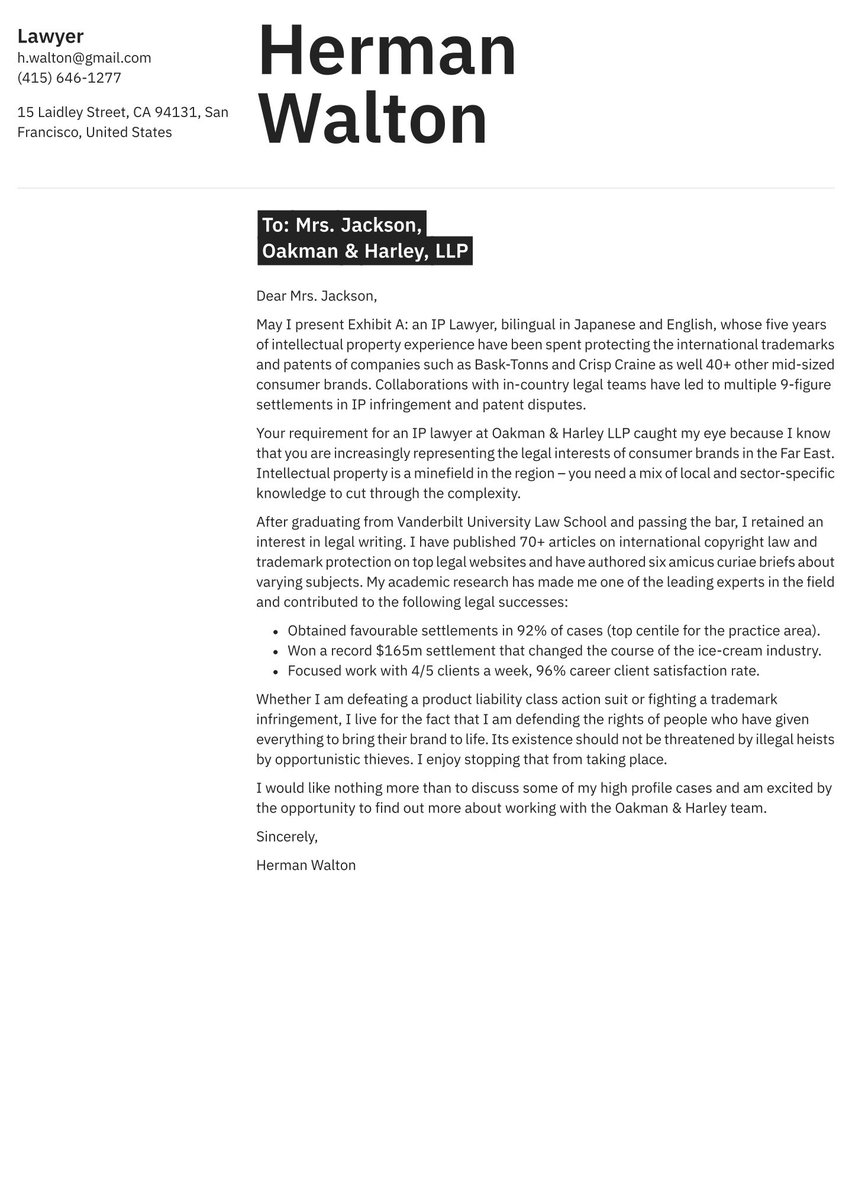Chemistry combines detail orientation with creativity. The best chemists don’t merely observe, they question, create, and innovate. When you prepare application documents for your job hunt, your main task will be to demonstrate those skills. That’s where a chemist cover letter can make a big difference.
Your chemist resume will detail your achievements, but in your cover letter, you have the opportunity to describe your research style and results. Plus, you can speak directly to the hiring manager to explain what unique skills and attributes you will add to the team. Because it is freeform, a cover letter may seem more challenging to write than a resume, but you’re in good hands with Resume.io. Our tools and templates will make the process smoother than you imagine.
Below you will find a chemist cover letter example and a corresponding writing guide designed to
- Detail why a cover letter is so important and what its goals are
- Describe each section and offer writing tips to help you make the most of the space you have
- Explain how to avoid common mistakes job hunters make in their cover letters.
If you’re looking for additional inspiration for cover letter writing, you can check out our related scientific field cover letter samples:
Best format for a chemist cover letter
Chemists are expected to be exacting. You can demonstrate this trait in the formatting of your chemist cover letter. Before you think about the content, you need to know what goes into your letter.
The format of a chemist cover letter should contain the following elements:
- The cover letter header
- The greeting/salutation
- The cover letter intro
- The middle paragraphs (body of the letter)
- The ending paragraph of your cover letter (conclusion and call-to-action)
Why bother with a cover letter?
Even if the job listing does not request a cover letter, you’re better off writing one. Going the extra mile never hurts and when you’re looking for a job, distinguishing yourself from other candidates is a great idea.
Here are the two main reasons to write a cover letter:
- To make a personal connection with the hiring manager
- Expand upon the details in your resume and answer any questions, such as gaps or a career change, that your job history may prompt.
If you’re looking for general advice on application letters, the comprehensive cover letter guide has you covered. Below, you will find specific tips and ideas for your chosen career.
This chemist cover letter example will give you a blueprint for writing your own cover letter:
Dear Dr. Walkenden,
I have worked as a chemist within the Bioscience industry for the past two years and am looking for a new role after my move to New York.
As the lead chemist in charge of control testing and data management at HalGen, I led training on how we incorporated spectroscopy, chromatography, and spectrophotometry into our laboratory work. I was working with five labs simultaneously – in charge of the medical environment and responsible for process alignment.
I have a PhD in qualitative analysis and am intensely data-driven in my approach to experimental science. We reduced experimental malfunctions by 22% last year – much of which was due to improved operating procedures. I am currently undertaking a second PhD in molecular chemistry and hope that my thesis on nuclear magnetic resonance will benefit my future employer. I know that your research priorities will match the direction of my work.
I have experience with the latest technology, and I know that you will be upgrading your lab spaces after the recent acquisition. It is easy to make costly mistakes when equipping a lab space and hopefully my knowledge of the supplier base could come in useful. The high-performance liquid chromatography field has seen some landmark advances recently.
I hope to share my thoughts on your development plans if we have the opportunity to meet for an interview. The role was recommended to me by Dr. Lateholm, who I believe has been in touch with you to recommend my candidature.
Sincerely,
Karl Halfmeier
Cover letter header
The header is the first chance in your chemist cover letter to grab the eye of your reader while offering your contact details. You want to keep this subdued – chemistry is a serious profession and you want to adopt the correct tone from the beginning.
Include your name, title (if it is related to the position you seek), and the best email address and telephone number at which to reach you. While an immediate response to recruiter contact is not necessary, you do want to get back to them within a day, so make sure you offer contact information that you check frequently. And check your spam folder, too, just in case.
It’s true that algorithms and Applicant Tracking Systems don’t see design, but you may be required to upload complete documents as PDFs into an HR system, so it’s best to create an eye-catching cover letter header – and align the style with that of your resume. If you are using Resume.io’s builder tool and templates, the job has been done for you.
Cover letter greeting
The environments in which chemists work are formal and maintain strict procedures to ensure safety and that experimental results are not tainted. Unless you are applying to work in a setting in which you know the culture, reflect this formality in the greeting of your chemist cover letter.
You can’t go wrong with “Dear Dr./Ms./Mr. [Surname]” unless you get the spelling or honorific incorrect. You are a research expert, so find out how your contact likes to be addressed before you make an assumption.
At times, a contact person is not listed. This is another occasion to do some investigating. The company or lab website, LinkedIn, or a professional organization may help here. Or, simply pick up the phone and ask to whom you should address your job application.
In case you cannot find a person’s name, or a committee will be reviewing your application, you may go with “Dear Hiring Committee,” “Dear Chemistry Department” or the like.
Get personal
If you have a commonality with the addressee, for instance, if you went to the same school or worked in the same place at different times, bring it up. Any connection you can make will help keep you in the hiring manager’s mind when it’s time to schedule interviews.
Cover letter introduction
You’ve gotten your reader’s attention with a personal greeting, now it’s time to get down to the reason for your chemist cover letter: illustrate what you can do for the company or lab. Let’s face it, this isn’t about you; it’s about solving a problem your prospective employer has.
Jump right in with a sentence describing your career and how your skills will make their life easier. Have you improved products or processes, designed experiments that added to knowledge in your field, or found a new use for an existing chemical? That’s your introduction.
The goal of this section: pique your reader’s interest by offering them the answer to their problem.
Dear Dr. Walkenden,
I have worked as a chemist within the Bioscience industry for the past two years and am looking for a new role after my move to New York.
Cover letter middle part (body)
The cover letter body, or middle part, is where you stack the evidence in your favor. Elaborate on how you made your greatest discovery and explain how those methods will apply at your targeted employer. Discuss how you collaborated with other scientists to improve results.
Use the first to detail that great achievement, but take the second to really hammer home how your expertise and skills are likely to lead to contributions in the new position. Describe your communication style or another interpersonal attribute that was difficult to illustrate in your resume.
Use the third paragraph of the body section to break up the text with a bulleted list of accomplishments that fit the job, but need no further explanation. You may choose to mention an award you earned, an advanced degree you are working on, or another workplace accomplishment.
Remember to answer any potential questions your job history may bring up such as why you are moving from one environment to another or what you were doing for that year you weren’t working. If you have space, include a more personal detail such as what inspires you as a scientist or why you chose the research area in which you work.
Use the STAR method
The STAR method may help give structure to your accomplishments. Briefly describe the Situation, the Task required of you, the Action you took, and your Results. Remember to choose situations that you may encounter in the job you seek. If it’s relevant, you may add a reflection or what you learned from the situation.
The goal of this section: bolster the case for your employment with examples that show you can do the job.
As the lead chemist in charge of control testing and data management at HalGen, I led training on how we incorporated spectroscopy, chromatography, and spectrophotometry into our laboratory work. I was working with five labs simultaneously – in charge of the medical environment and responsible for process alignment.
I have a PhD in qualitative analysis and am intensely data-driven in my approach to experimental science. We reduced experimental malfunctions by 22% last year – much of which was due to improved operating procedures. I am currently undertaking a second PhD in molecular chemistry and hope that my thesis on nuclear magnetic resonance will benefit my future employer. I know that your research priorities will match the direction of my work.
I have experience with the latest technology, and I know that you will be upgrading your lab spaces after the recent acquisition. It is easy to make costly mistakes when equipping a lab space and hopefully my knowledge of the supplier base could come in useful. The high-performance liquid chromatography field has seen some landmark advances recently.
How to close a chemist cover letter (conclusion and sign-off)
Your reader has made it this far and that’s a great sign. Now you need to use the conclusion of your chemist cover letter to remind them of why you are an excellent candidate. Restate your original argument and explain why you want to work for the company if you haven’t already.
Before you close, make it clear that you want to discuss the opportunity further with a polite request for an interview. The cover letter example text below offers one way to accomplish that.
Finally, end your letter with a simple “Sincerely,” or “Best regards,” and your full name.
The goal of this section: refocus your reader on the reasons you are an excellent candidate and request an interview.
I hope to share my thoughts on your development plans if we have the opportunity to meet for an interview. The role was recommended to me by Dr. Lateholm, who I believe has been in touch with you to recommend my candidature.
Sincerely,
Karl Halfmeier
Basic mistakes in a chemist application letter (and how to avoid them)
- Copy-and-pasted text. A generic cover letter is a red flag. If you want an employer to take the time to read your application materials and spend some real time talking with you, you need to take the time to talk directly to them. Yes, your major accomplishment won’t change from letter to letter, but how it applies to each environment and the goals of the company may.
- The wrong tone or style. While you may work in a very casual research lab, don’t make the mistake of thinking that all research labs have a casual culture. Adopt a professional tone, but try to maintain your voice. You don’t want to come off as standoffish any more than you want to seem like you’re chatting with friends.
- Neglecting soft skills. Recruiters say that they look for soft skills as much as hard skills when they review resumes. Scientists need to be creative thinkers, collaborators, and communicators as well as experts in chemical compounds. Present yourself as a well-rounded employee.
- Lack of attention to detail. By this, we mean typos and grammatical mistakes, but also being vague about your accomplishments. You’re a scientist who does precision work, so you need to be precise about exactly what you discovered and what the results of your discovery were. As for the typos, spell check is a good start, but have a trusted colleague, friend, or professional read your cover letter. You’d be amazed what a human being can find that a computer may not. This step can help you avoid mistakes in tone and voice as well.
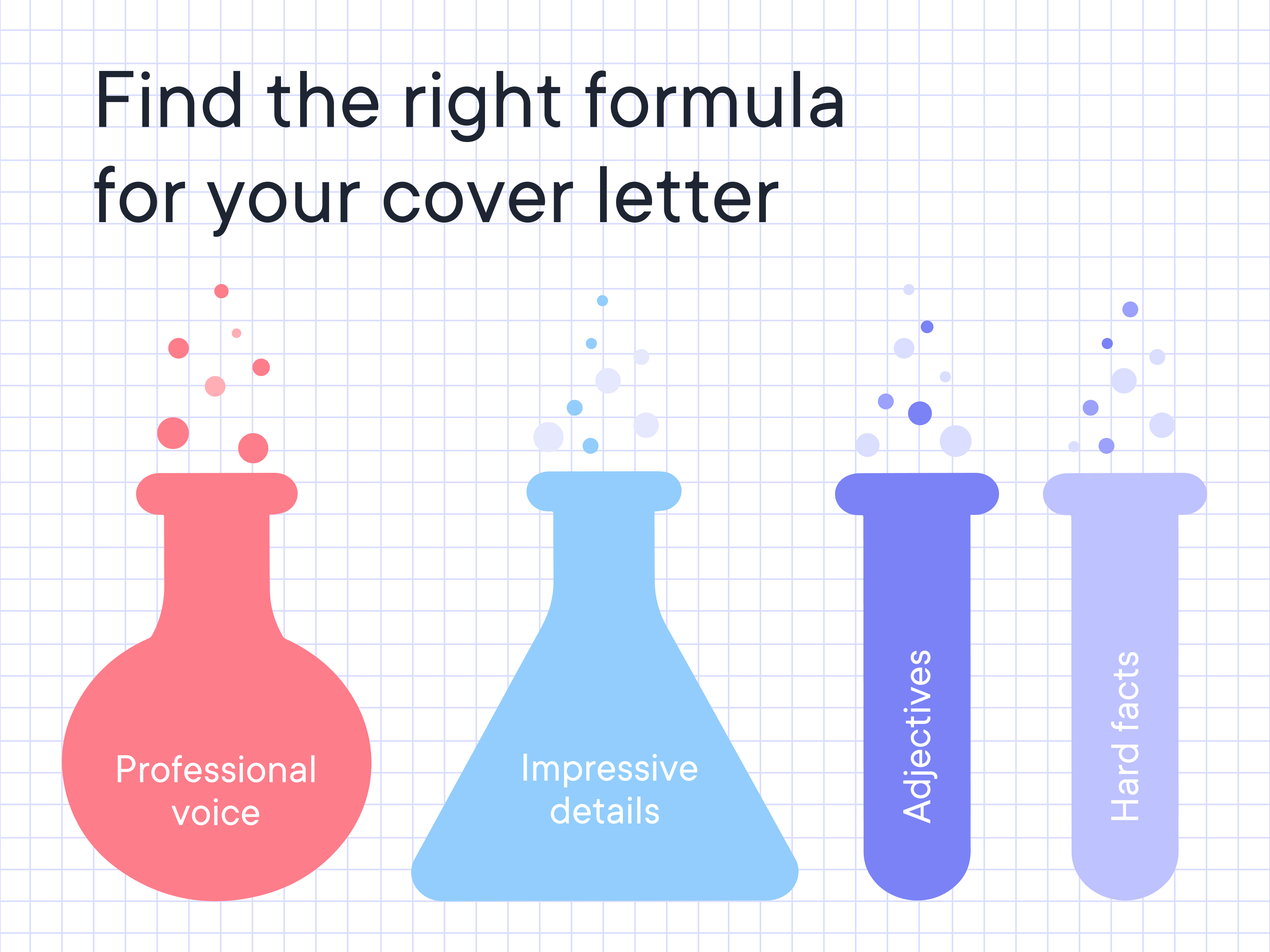
Key takeaways
- You can’t go wrong by including a cover letter in your application even if one is not requested.
- This one-page document is a great opportunity to distinguish yourself from other chemists and make a personal connection with your reader.
- Use your letter to illuminate an aspect of your professional life or personality that did not fit into your resume.
- Personalize each application document. No two jobs are exactly alike and no two cover letters should be either.


